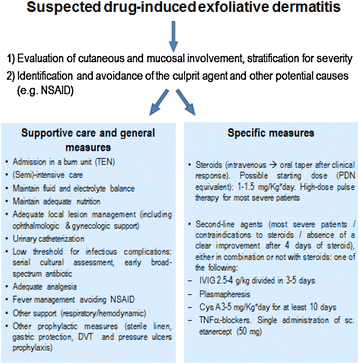Drug induced exfoliative dermatitis: state of the art
- PMID: 27551239
- PMCID: PMC4993006
- DOI: 10.1186/s12948-016-0045-0
Drug induced exfoliative dermatitis: state of the art
Abstract
Drug induced exfoliative dermatitis (ED) are a group of rare and severe drug hypersensitivity reactions (DHR) involving skin and usually occurring from days to several weeks after drug exposure. Erythema multiforme (EM), Stevens-Johnson syndrome (SJS) and toxic epidermal necrolysis (TEN) are the main clinical presentations of drug induced ED. Overall, T cells are the central player of these immune-mediated drug reactions. Here we provide a systematic review on frequency, risk factors, pathogenesis, clinical features and management of patients with drug induced ED.
Keywords: Clinical features; Delayed type hypersensitivity; Drug hypersensitivity; Erythema multiforme; Exfoliative dermatitis; Lyell’s syndrome; Pathogenesis; Stevens–Johnson syndrome; Therapy; Toxic epidermal necrolysis.
Figures



References
-
- Fritsch PO. Erythema multiforme Stevens–Johnson syndrome and toxic epidermal necrolysis. In: Eisen AZ, Wolff K, editors. Fitzpatrick’s dermatology in general medicine. New York: McGraw-Hill; 2003. pp. 543–557.
-
- Fritsch PO. Erythema multiforme and toxic epidermal necrolysis. In: Eisen AZ, Wolff K, editors. Fitzpatrick’s dermatology in general medicine. New York: McGraw-Hill; 2003. pp. 585–600.
Publication types
LinkOut - more resources
Full Text Sources
Other Literature Sources

